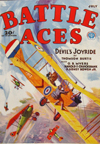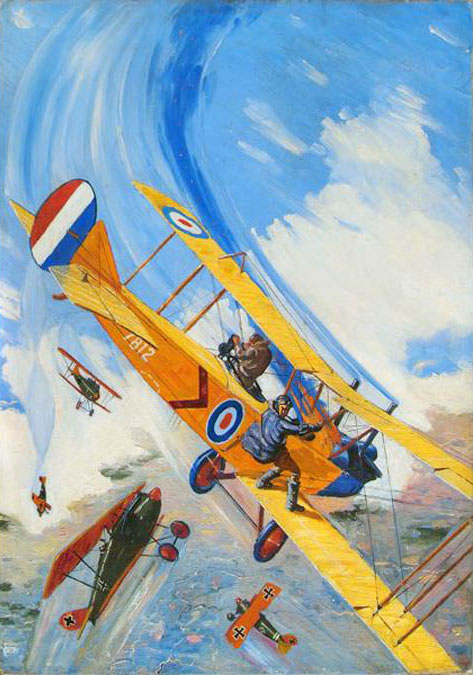“The B.E. Fighters” by Frederick Blakeslee
Editor’s Note: Every month the cover of BATTLE ACES depicts a scene from a real combat actually fought in the War and a real event in the life of a great ace. The series is being painted exclusively for this magazine by Frederick M. Blakeslee, well-known artist and authority on aircraft and was started especially for all of you readers who wrote in asking for photographs of war planes. In this way not only do you get pictures of the ships—authentic to the last detail—but you see them in color. Also you can follow famous airmen on many of their most amazing adventures and feel the same thrills of battle they felt. Be sure to save these covers if you, want your collection of this fine series to be complete.
 IN THIS month’s cover a B.E. has penetrated deep into enemy territory on a reconnaissance trip. While harassing troops it is sighted by a patrol of Pfaltz Scouts. The Jerries dive immediately, surrounding the lone Allied ship in a trap of wings and spitting Spandaus. Valiantly the observer hammers away at his guns and has already succeeded in knocking one of the Boche out of control when fire breaks out in the front cockpit. Leaving the observer to stave off the attackers with his blazing Vickers, the pilot straddles out onto the lower wing and continues to fly the ship from there, controlling it from the side of the fuselage.
IN THIS month’s cover a B.E. has penetrated deep into enemy territory on a reconnaissance trip. While harassing troops it is sighted by a patrol of Pfaltz Scouts. The Jerries dive immediately, surrounding the lone Allied ship in a trap of wings and spitting Spandaus. Valiantly the observer hammers away at his guns and has already succeeded in knocking one of the Boche out of control when fire breaks out in the front cockpit. Leaving the observer to stave off the attackers with his blazing Vickers, the pilot straddles out onto the lower wing and continues to fly the ship from there, controlling it from the side of the fuselage.
The incident is taken from an actual combat fought in the latter part of the war. The observer was Lieutenant H.W. Hammond, R.F.C., who was awarded a bar to his previously won Military Cross for his part in the fight.
With his pilot, Lieutenant Hammond had flown over the lines and was well into Boche territory when eight German fighting planes dived down on them. The unequal combat began with a savage burst of steel and flame. Knowing their only hope lay in getting back across the lines as swiftly as possible, the pilot held the nose of the ship toward home while the observer blazed away at the swarm of Jerries. By skillfully directed fire from his guns, Hammond succeeded in shooting three of the black-crossed wings down out of control. But he himself was wounded in half a dozen places and it looked as if the remaining Boches would be finishing them off any second.
Then that horror of all airmen—fire—broke out. The front cockpit became a blazing holacaust that threatened the lives of both men. Climbing over onto the lower wing, the pilot calmly continued to fly the ship from there, manipulating the joystick from the side of the fuselage! In a long turning side-slip to the right, which blew the flames away from the observer and himself, they started earthward.
They crashed in No-Man’s-Land, where they were rescued by infantry.
The B.E. was a reconnaissance plane which proved very successful, also, in destroying Zeppelins. The name, B.E., at first indicated Bleriot Experimental, Monsieur Bleriot being credited with having originated the “tractor” type machine. But later on it took the meaning of British Experimental. It was developed in several series. A later type was numbered B.E.2, B.E.2b, B.E.2d and B.E.2e, the two last being built in very large quantities. The general type was also made along different lines, as the B.E.3, B.E.4, etc., up to B.E.12.
The observer for a reconnissance plane had a two-fold job; to photograph, and, if necessary, to fight. The ship was not exactly the cold meat that one might expect; it was equal in combat to two Scouts but was always their prey if outnumbered.

“The B.E. Fighters” by Frederick M. Blakeslee (Battle Aces, July 1931)
Next month, the cover design illustrates another type of reconnaissance plane, the R.E. 8, in a stirring incident that commemorates a deed of outstanding daring.




